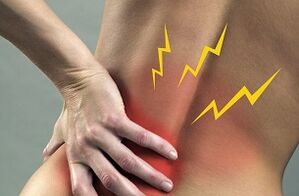
If a person has been working hard, playing sports intensively, or walking long distances, at a reflex level, he puts his hands to his lower back as he stops and rests. It is this part of the body that is interesting and sore after exercise, which is explained very simply. The spine is the main support of the human skeleton. It connects all the articular joints and takes most of the pressure in any movement. Therefore, it is desirable if, after work or sports, the lower back hurts and aches.
But not always the cause of back pain in the lumbar region is too much work. Lower back pain is often a symptom of a serious disorder in the human body; it cannot be ignored, especially if the pain is severe, often recurrent. This is a sign that an unknown pathology has developed and is causing more harm to the body every day. It is advisable to see a doctor as early as possible: neglected problems with the spine are difficult to treat and can end up in a wheelchair for patients.
It is interesting:Researchers believe that back pain in the spine is a result of human evolution, and more precisely, bipedal movement. In animals moving with four limbs, the load is evenly distributed. One has to pay for government posture and the ability to walk on two legs with violations of load distribution, curvature of the spine and back pain.
What can be back pain
Your back can hurt in a variety of ways. Sometimes the pain is sharp, unbearable, the patient feels an unbearable burning sensation and a sharp limitation of movement. More often, patients complain of pain in the lower back, pulling, unpleasant sensations that usually appear in the evening, being able to wake up in the middle of the night, intensifying when the weather changes or after doing physical exercise.

Morning cramps in the spine, back pain "for the weather" and after exercise are the first signals that the joints are out of order.
Pain in the back is always accompanied by additional symptoms, which you must pay attention to and inform the doctor about your observations. According to the accompanying symptoms, it will be easier to determine the true cause of pain in the lumbar spine. So, what symptoms and criteria will be of diagnostic value:
- Duration (severity) of pain. Acute pain syndrome is called, which is alarming for up to three months. If it occurs periodically for four months or more, it has varying intensity, then it is already referred to as chronic.
- Localization. Back pain that radiates to the back is commonly called lumbodynia in medicine. If the pain affects the foot, then it is lumboischialgia. Also, unpleasant sensations can only occur on the right, on the left, or on both sides at once.
- The nature of pain. This criterion is very important. The pain can be acute and localized at one point, it can be projected to the limbs, buttocks, groin, hypochondrium or lower abdomen. The pain is severe, dull, or throbbing. The hardest thing is making a correct diagnosis for joint pain.
- Effects on joint mobility. The doctor will certainly explain whether there is stiffness in the spine, limbs, hip joints, under what conditions, how long it lasts.
- Time indication. It is also important when and after that the back starts to ache. This happens all the time, in the morning, in the evening, at night, after exercising, when turning the head, walking, bending over, etc. - the answers to all these questions are very important for a correct diagnosis.
On a note:according to doctor statistics, more than 80% of the European population has experienced back pain at least once in their lives. More than 25% of medical visits are due to discomfort and pain in the lumbar region. Moreover, 8 out of 10 patients were active young people, working ages from 35 to 45 years. Less frequently, retirees complain of lower back pain, and less frequently adolescents.
The reasons
All causes of back pain can be divided into two broad categories:
- physiology, usually due to external factors;
- pathology, associated with diseases of internal organs.
Physiological causes include:
- excessive physical activity while playing sports;
- lifting and carrying weights at work or in training;
- hard work at home or in the country;
- hypothermia, prolonged stay in a damp room.

Age combined with physical labor is a sufficient reason for back pain.
The pathological cause of back pain, in turn, may be related to spinal diseases or age -related changes in its structure - this pain syndrome is called primary. If back pain is caused by dysfunction of other organs, for example, kidneys, it is called secondary - in this case, it is necessary to perform background disease with the help of additional specialized studies and treat two pathologies simultaneously.
Diseases and conditions in which the lower back can ache:
- osteochondrosis (spondylosis) - previously it was diagnosed mainly in the elderly, now it is detected at any age;
- intervertebral hernia - also occurs at any age, if in young people, usually after excessive strength sports;
- neuralgia of different nature;
- arthritis and arthrosis, any inflammatory process in the joints;
- rheumatism and other diseases of autoimmune origin;
- radiculitis;
- endocrine system dysfunction (diabetes mellitus, hyperthyroidism);
- inflammation of the renal pelvis - pyelonephritis;
- inflammation of the genitourinary organs.
Back or limb injuries are also painful. To determine the exact cause, you need to undergo several examinations, the minimum that must be done is an external examination by a specialist, laboratory tests of urine and blood, X-rays, electrocardiogram, ultrasound of the kidneys and genitourinary organs. If necessary, additional diagnostic measures will be provided.
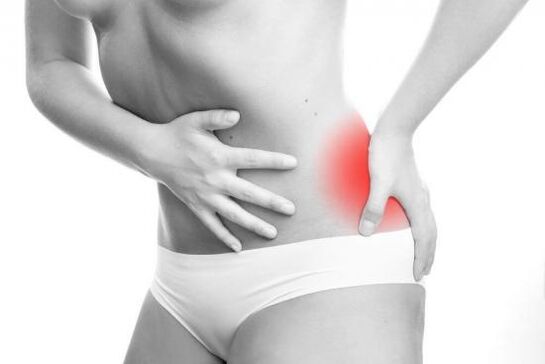
In women, back pain can be caused by cystitis or inflammation of the appendix.
Spinal disease as a cause of back pain
If the X-rays show deformation of the vertebrae, its compaction and expansion with the formation of bone growth in the form of thorns along the edges, the doctor diagnoses osteochondrosis or spondylosis. Until recently, this pathology was considered a retired disease, and its main causes were mentioned age-related changes naturally in the body, slowing of metabolic processes and wear of the vertebrae.
Today it has been proven that osteochondrosis can be triggered by a number of other factors in young people as well as adolescents. The impetus for degenerative changes in the vertebral and intervertebral discs are:
- inadequate physical activity with overweight or due to chronic diseases that limit movement;
- inactive work;
- metabolic disorders during the diet, for example, as a result of vertebral structures not getting enough nutrients and premature wear and tear;
- improper exercise - without warming up the muscles and ligaments, without a gradual increase in load and load lifting control.
With osteochondrosis, as it develops, deformation of the intervertebral disc occurs - it becomes flat, dense and rough. The affected disc can easily pinch the nerve root, which branches from the spinal space, causing inflammation. In addition, nerve roots are injured by bony spinal processes. The patient feels this as a sharp, sharp pain, where there is a limitation of movement in the lower back. This condition is called sciatica.
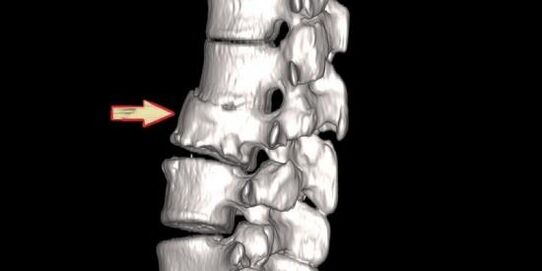
In spondylosis, bone growth along the edges of the vertebrae injures nerve roots and thus gives rise to acute pain syndrome.
The inflammatory process in the spine can begin to develop as early as adolescence and adolescence. It manifests itself as recurrent back pain, sometimes bothersome at night. Then they combine with morning stiffness, fatigue, and decreased physical activity. At a later stage, the spine is severely deformed, changes a person’s posture and gait, and the shape of the hump. Rheumatoid arthritis can develop over years, in some cases up to ten years. Because the disease is slow, the symptoms are often vague, the patient does not go to the doctor, trying to overcome the discomfort in an improved way. For this reason, inflammation of the vertebral joints more often than other pathologies causes deformities.
If the patient during the survey mentions discomfort in other joints (shoulders, legs, knees, hands), complains of pain in the back, decreased visual acuity, stool disorders, spondyloarthritis can be suspected. A rheumatologist is involved in the treatment of such pathology, his consultation is needed immediately, because the pathology develops rapidly and leads to irreversible changes in bone and articular structure.
Diseases not related to the back as a cause of pain
Sometimes pain in the lower back causes disease in organs that, at first glance, have nothing to do with the spine. Myofascial pain syndrome is a common cause of back pain, which is not accompanied by other symptoms of joint pathology. Typically, young women come to the doctor with complaints of pain in the back after a day of work, intensive training in the gym, or long stays in one position.
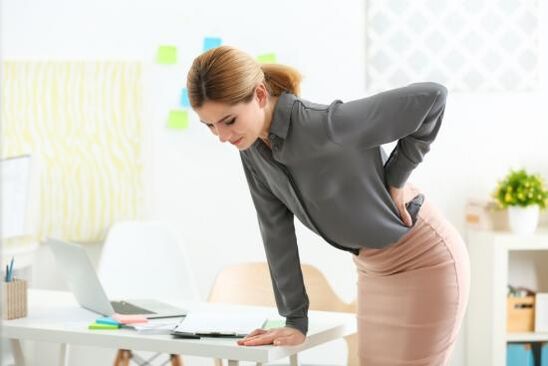
Pain in myofascial syndrome is not associated with damage to the spinal joints and is easily relieved with analgesics, massage and NSAIDs.
During the examination, the doctor easily detects a point near the spine, when pressure is applied to the occurring pain. Pain caused by tension of muscle tissue, nerve roots and articular elements does not suffer. This condition does not pose a major threat to the health of patients, but can significantly reduce the quality of life. For treatment, doctors prescribe muscle relaxants - drugs that promote muscle relaxation, as well as short -term non -steroidal anti -inflammatory drugs in minimal doses. Recommended to arrange rest and bed rest and monitor physical activity.
Other extra-articular pathologies that may also be accompanied by pain in the spine:
- Cholecystitis and pancreatitis. The pain is localized in the right hypochondrium and can be projected to the right lower back.
- Appendix. In some cases, a sharp and stabbing pain radiates to the lower back, also on the right side. Additional symptoms of appendicitis: bloating, stool disturbances, nausea, vomiting, severe pallor, fever.
- Renal dysfunction, urolithiasis. Depending on which kidney is inflamed, pain will occur in the right or lower left back. If the stones come out with urolithiasis, the lower back is also severely sore, in difficult cases the body temperature may rise.
- Obesity. With excess weight, a heavy load is placed on the lumbar spine, which causes pain and discomfort in the back.
- Osteomyelitis. Bone infections are accompanied by severe pain and fever.
If during the examination no lesions of the spine or other joints are visible, internal organ disease cannot be detected, it makes sense to donate blood for tumor markers and do an MRI of the spine. Malignant tumors, as they grow, put pressure on nerve roots and also cause pain. Pain syndrome is a hallmark of stage 3-4 cancers.
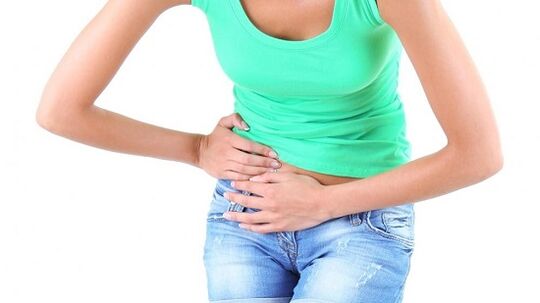
Pain in the lumbar region can be a symptom of appendicitis.
Why does the back hurt in women
If a woman is experiencing severe back pain in the lumbar region, first of all, you should review your individual calendar. Exciting pain can interfere before menstruation, while also pulling the lower abdomen, swelling of the mammary glands, nausea patients, some are tormented by migraines, food intolerance, or conversely, dizziness.
Roughly the same symptoms are a sign of pregnancy. Therefore, if for several days menstruation has not begun, and the pain and discomfort persist, it makes sense to undergo a pregnancy test and make an appointment with a gynecologist.
Even so, the cause may be a gynecological disease. Adnexitis is usually manifested by pulling pain in the lower abdomen. But sometimes they radiate to the lower back. A similar sensation occurs when an ovarian cyst is twisted. With the onset of menopause, many women complain of a burning sensation in the lower back, cramps. In any case, a therapist or rheumatologist will advise you to see a gynecologist.
Causes of pain in men
In men, the back hurts mainly due to professional activities - hours of driving, working at computers, lifting and carrying loads, professional sports.
But pain in the right or left side of the back can be one of the symptoms of prostatitis or a pathology such as epididymitis. To exclude or confirm pathology, you need to be examined by an andrologist.
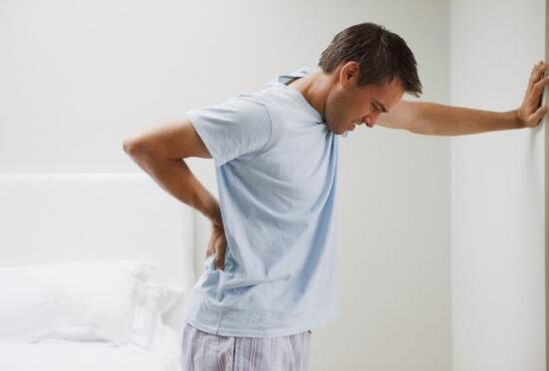
Men who suffer from back pain should definitely see an andrologist to rule out prostatitis.
When and what treatment is needed
Even with very strong and persistent back pain, most patients do not believe that they need serious treatment, and only expect one thing from the doctor - a good painkiller for immediate and for a long time. Unfortunately, there is no such cure. The pain syndrome can be eradicated with injections and pills, but the effects will not last long, as the cause of the discomfort will not be eliminated. The method of treatment will be determined depending on what is triggering the back pain.
Muscle bruises and sprains
The first thing to do is to give full rest to the buttocks. This means you can’t exercise, lift weights, stand a lot, walk, run, jump, and overdo it. It is recommended to get rid of extra pounds, with sedentary work and an inactive lifestyle, on the contrary, you should think of more economical sports - for example yoga, Pilates, swimming. In the future, you will need to reconsider your habits and adjust the load on the spine.
What to do before seeing a doctor:
- taking analgesic or non-steroidal anti-inflammatory drugs at minimal doses;
- pair the lower back with an uncomfortable corset - a towel or scarf;
- to reduce swelling, drink herbal tea with diuretic effect.
What the doctor will advise:
- short-term non-steroidal anti-inflammatory drugs;
- muscle relaxation to relieve muscle cramps and tension;
- massaging and warming the buttocks (in the absence of inflammatory processes);
- Vitamin B.
If you follow all the recommendations, the pain will disappear completely in 7-14 days.
Remember!If an increase in body temperature is detected, pain is given to the legs or other parts of the body, limited mobility, or other atypical symptoms occur, if you need the help of a chiropractor, do a warm -up or self -massage. It is also not recommended to take painkillers, as this will complicate the diagnosis.
Spinal pathology
Early joint disease is treated using the same techniques as bruises or other injuries. In addition, doctors may prescribe chondroprotectors - drugs that protect the articular structure from destruction and stimulate its recovery.
For compression spine fractures, extensive intervertebral disc herniation, severe forms of osteochondrosis or spondyloarthritis, surgical intervention is indicated. Depending on the violation detected, surgery can be easily performed and performed under local anesthesia, or performed in several stages for six months. After surgery of any complication, it is necessary to take antibiotics, wear bandages, and physical therapy for full recovery.
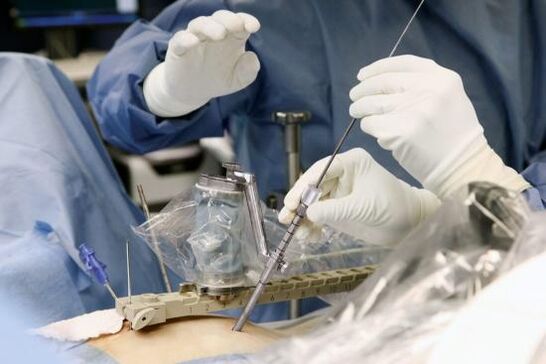
Modern technology makes it possible to perform minimally invasive interventions on the spine with minimal risk of complications.
Today, spine surgery is no longer uncommon, rich and varied experience has accumulated, there is special equipment that allows you to solve almost any problem. Therefore, if the situation is difficult and the doctor has recommended surgery, there is no point in postponing it. The sooner it is done, the more chances you have of pain relief and restoration of spinal function.
Useful hints
Timely and effective treatment of lower back pain is often difficult for a very common reason - patients don’t know which doctor to consult. If the pain is preceded by an injury, then everything is simple - you need to go to a traumatologist. He will most likely prescribe analgesics and non -steroidal anti -inflammatory drugs, and then recommend various physiotherapy procedures - electrophoresis, magnetotherapy, massage therapy and exercise. This is the standard treatment for back injuries.
The difficulty is that when hit or dropped, the nerve endings can be affected. And then you need to involve a neurologist who will recommend his own method of treatment. A rheumatologist or orthopedist will have their own opinion. And if, during the examination, the pathology of any internal organ, for example, the genitourinary system, is expressed, the patient will be completely confused about what to treat and who to listen to. By the way, this is why many people abandon formal medical methods and turn to traditional medicine, not traditional medicine, which eventually causes the condition to worsen and complications arise.
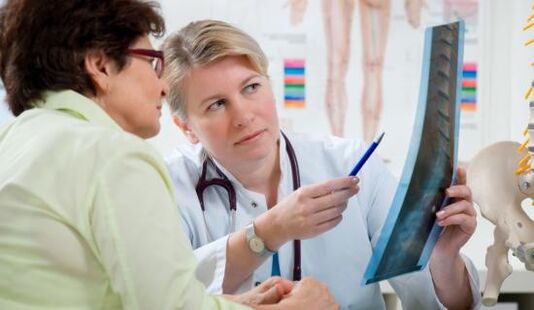
Coincidentally the doctor made the wrong diagnosis and prescribed the wrong treatment, which led to the development of the disease and complications.
What to do in such a situation? Don’t panic or rush, but undergo the prescribed treatment to the end, focusing on your own feelings and well-being. If, after two to four weeks, the back feels sore at all and there is no improvement at all, it makes sense to contact another doctor and undergo a second examination to check the truth of the diagnosis. Changing one analgesic to another, rather than electrophoresis, does not make sense to do UHF.
Regarding the treatment of the buttocks with homeopathic remedies at home, here too, one should not get carried away and believe in the promises of traditional healers. Adequate adults must understand: traditional methods of treatment are either at the stage of remission, when the condition is stable, or for the prevention of relapses and complications. Rheumatoid arthritis, for example, as an autoimmune disease, herbal tinctures cannot be cured in any way.

Medicinal plants will help improve overall body tone, but are unlikely to help with hernias, disc dislocations, or compression fractures.
The right decision is if the lower back is always sore, and the doctor's appointment at the district clinic is not effective - go to a well -known private clinic and undergo an examination there. It’s not free, but you’ll find out the real cause and be able to start the right treatment, and not experiment with standard folk remedies and painkillers that don’t give a therapeutic effect.
Summary:Almost all adults experience back pain at least once in their lives. In fact, there are many reasons: from too much work to serious pathology of the spine, kidneys, infections or metabolic disorders in the body. It is important to determine the cause accurately and correctly and begin appropriate treatment as early as possible. The spine is a major joint in the human skeleton, its dysfunction and destruction in the absence of adequate medical treatment will inevitably lead to loss of mobility and disability.































